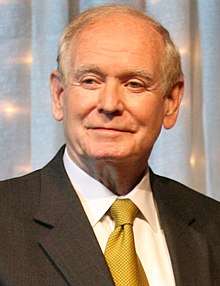Robert D. Ray
| Robert D. Ray | |
|---|---|
 | |
| 38th Governor of Iowa | |
|
In office January 16, 1969 – January 14, 1983 | |
| Lieutenant |
Roger Jepsen Arthur Neu Terry Branstad |
| Preceded by | Robert D. Fulton |
| Succeeded by | Terry Branstad |
| Chair of the National Governors Association | |
|
In office June 8, 1975 – July 4, 1976 | |
| Preceded by | Calvin L. Rampton |
| Succeeded by | Cecil D. Andrus |
| Mayor of Des Moines Acting | |
|
In office May 5, 1997 – November 3, 1997 | |
| Preceded by | Arthur Davis |
| Succeeded by | Preston Daniels |
| Personal details | |
| Born |
Robert Dolph Ray September 26, 1928 Des Moines, Iowa, U.S. |
| Died |
July 8, 2018 (aged 89) Des Moines, Iowa, U.S. |
| Political party | Republican |
| Spouse(s) |
Billie Hornberger (m. 1951) |
| Education | Drake University (BA, LLB) |
| Military service | |
| Allegiance |
|
| Service/branch |
|
Robert Dolph Ray (September 26, 1928 – July 8, 2018) was an American lawyer and Republican politician. He served as the 38th Governor of Iowa from January 16, 1969 to January 14, 1983.
During his tenure as governor, Ray served as chair of the National Governors Association from 1975 to 1976; led to the passage of the Iowa Burials Protection Act of 1976, which was the first legislative act in the United States that specifically protected American Indian remains;[1] and accepted thousands of refugees into Iowa.[2]
In his later years, Ray served as acting mayor of Des Moines from May 1997 to November 1997 and was interim president of Drake University in 1998.
Early life
Ray was born in Des Moines, Iowa, in 1928. Ray's father was Clark Ray, an accountant. ray's mother was Mildred Ray. [3] Ray graduated from Roosevelt High School in 1946. After high school, Ray served in the United States Army.[4]
Education
Ray received a B.A. in business from Drake University in 1952 and a law degree in 1954.[4]
Career
Ray began his career as a trial lawyer. Following several years practicing law, Ray became chair of the Iowa Republican Party in 1963.[4]
Governor of Iowa
In 1969, Ray became the Governor of Iowa. During Ray's time in office, the Iowa Constitution was modified, increasing the governor's term of office from two years to four years. Ray served as chair of the National Governors Association from 1975 to 1976. He also served as chairman of the Republican Governors Association, the Midwestern Governors Association, the Education Commission of the States and was the president of the Council of State Governments.[5] As Governor, Ray issued executive orders promoting civil rights, energy conservation, and paperwork reduction as well as establishing the Governor's Economy Committee, the Iowa Council for Children, the Task Force on Government Ethics, the Science Advisory Council, and the Iowa High Technology Commission.[6] Ray signed legislation establishing the Iowa Commission on the Status of Women in 1974.[7] In 1982, that commission named him the first recipient of the Cristine Wilson Medal for Equality and Justice.[8] In 1976, Ray, along with his wife Billie Ray and three daughters, became the first Governor of Iowa to occupy Terrace Hill, the official Governor's mansion.[9]
Ray served as a delegate to the United Nations Conference on Refugees in Geneva, Switzerland in 1979.[10] Ray was an advocate of the nickel deposit on aluminum cans.[11]
Ray's tenure in office was notable for his humanitarianism on behalf of Southeast Asian Tai Dam refugees.[12] Ray agreed to bring the group to the United States by creating his own refugee resettlement program.[2] Ray announced that the state of Iowa would accept 1,500 additional refugees in January 1979. Ray wrote letters to President Jimmy Carter and other governors asking them to support greater admissions of boat people.[13] Opinion polls from the period demonstrated Ray's refugee resettlement and relief efforts were very controversial.[2] Many feared competition for jobs, diversion of funds from needy native Iowans, and racial mixing.[12]
Ray also enacted the first laws in the U.S. that protected American Indian graves.[14] In the early 1970s, Maria Pearson was appalled that the skeletal remains of Native Americans were treated differently from those of caucasians.[14] Pearson protested to Ray, finally gaining an audience with him after sitting outside his office in traditional attire.[14] Ray cooperated with Pearson, and their work led to the passage of the Iowa Burials Protection Act of 1976, the first legislative act in the U.S. that specifically protected American Indian remains.[1] This act was the predecessor of the federal Native American Graves Protection and Repatriation Act.[1][15]
Life Investors Inc
After leaving the governor's office in 1983, Ray became CEO of Life Investors Inc, an insurance company. [4]
Mayor
Ray served as interim mayor of Des Moines from May to November 1997. [4]
Drake University
Ray was the interim president of Drake University in 1998.[4] In 1997, he helped form the Institute for Character Development at Drake University.[16]
Awards
In 2005, Ray became the only governor or former governor to have received Iowa's highest civilian honor, the Iowa Award, by the Iowa Centennial Memorial Commission.[17]
Health Care
Ray was co-chair (along with Bob Edgar) of the bipartisan National Coalition on Health Care.[18]
Personal life
In 1951, Ray married Billie Lee Hornberger, his high school sweet heart. Ray had 3 daughters. [4]
In Ray's later years, he suffered Parkinson's disease.
On July 8, 2018, Ray died at a nursing home in Des Moines, Iowa. He was 89. [4] [7]
References
- 1 2 3 Gradwohl, D. M.; J.B. Thomson; M.J. Perry (2005). Still Running: A Tribute to Maria Pearson, Yankton Sioux. Special issue of the Journal of the Iowa Archeological Society. 52. Iowa City: Iowa Archeological Society.
- 1 2 3 "Robert D. Ray: An Iowa Governor, a Humanitarian Leader". PBS. Retrieved July 8, 2018.
- ↑ "Former Governor Robert D. Ray Dies at 89". WhoTV. July 8, 2018. Retrieved July 8, 2018.
- 1 2 3 4 5 6 7 8 "Bob Ray, beloved 5-term Iowa governor, dies at 89". Des Moines Register. Retrieved July 9, 2018.
- ↑ Robert D. Ray, webpage, retrieved December 31, 2009
- ↑ Executive Orders of Governor Robert D. Ray, webpage, retrieved December 31, 2009
- 1 2 "Robert D. Ray, longtime Iowa governor, dies at 89". Politico. July 8, 2018. Retrieved July 8, 2018.
- ↑ Cristine Wilson Medal for Equality and Justice, webpage, retrieved December 31, 2009
- ↑ Homes of Iowa Governors, webpage, retrieved December 31, 2009
- ↑ "'He had to analyze everything'". QCTimes. Retrieved July 8, 2018.
- ↑ "Robert D. Ray". Iowa Heritage. Retrieved July 8, 2018.
- 1 2 Walsh, Matthew. The Good Governor: Robert Ray and the Indochinese Refugees of Iowa (McFarland & Co, 2017)
- ↑ "Former Iowa Governor Robert Ray dies at age 89". KETV. July 8, 2018. Retrieved July 8, 2018.
- 1 2 3 "Maria Pearson". Ameshistory. Retrieved July 8, 2018.
- ↑ Pearson, Maria D. (2000). "Give Me Back My People's Bones: Repatriation and Reburial of American Indian Skeletal Remains in Iowa". In G. Bataille; D.M. Gradwohl; C.L.P. Silet. Perspectives on American Indians in Iowa- An Expanded Edition. Iowa City: University of Iowa Press. pp. 131–141.
- ↑ Stateline Midwest, Vol. 18, No. 4, April 2009, p. 8, webpage, retrieved December 31, 2009
- ↑ Iowa Profile, webpage, retrieved December 31, 2009
- ↑ Annual Report of the National Coalition on Health Care, 2008 – 2009, webpage, retrieved December 31, 2009
| Party political offices | ||
|---|---|---|
| Preceded by William G. Murray |
Republican nominee Governor of Iowa 1968, 1970, 1972, 1974, 1978 |
Succeeded by Terry Branstad |
| Preceded by Robert Bennett |
Chair of the Republican Governors Association 1977–1978 |
Succeeded by Otis R. Bowen |
| Political offices | ||
| Preceded by Robert D. Fulton |
Governor of Iowa 1969–1983 |
Succeeded by Terry Branstad |
| Preceded by Calvin L. Rampton |
Chair of the National Governors Association 1975–1976 |
Succeeded by Cecil D. Andrus |
| Preceded by Arthur Davis |
Mayor of Des Moines Acting 1997 |
Succeeded by Preston Daniels |
| Academic offices | ||
| Preceded by Michael Ferrari |
President of Drake University Acting 1998–1999 |
Succeeded by David Maxwell |
